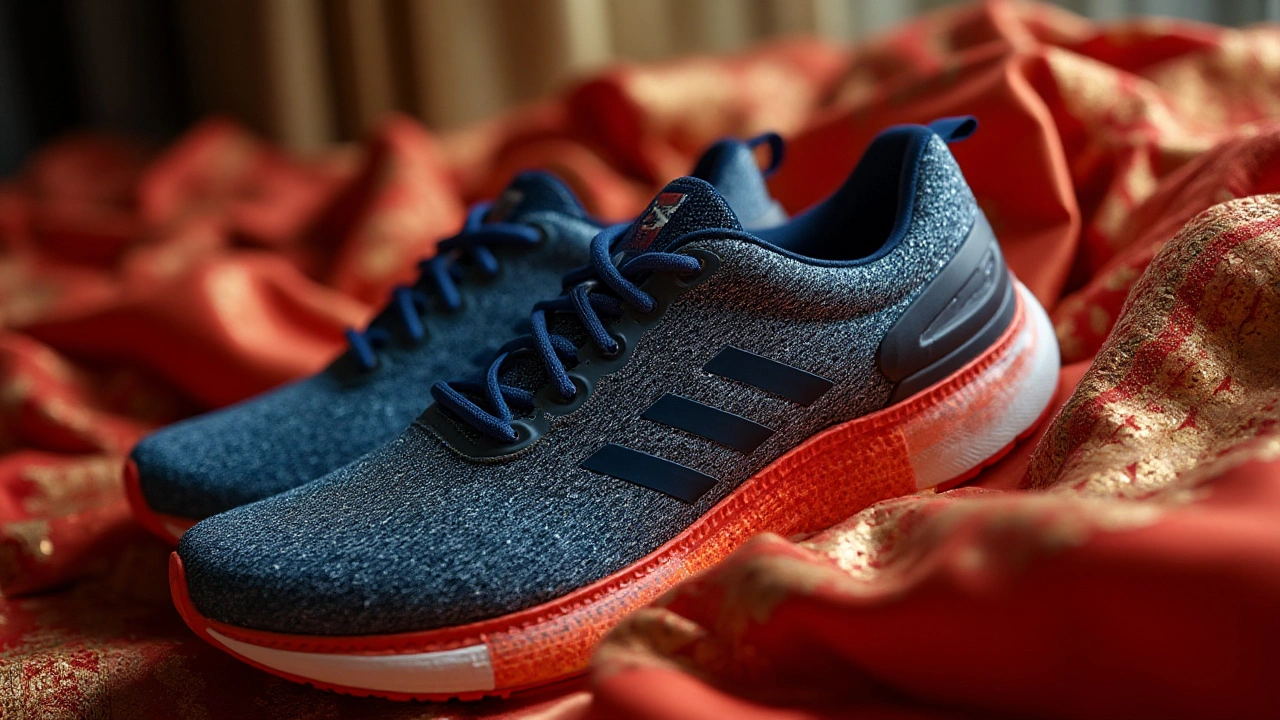Running shoes aren't just for the track anymore; they're stepping into the daily routines of many. Beyond their athletic roots, these comfortable kicks offer cushioning and support which could bode well for long days on your feet.
Many people wonder if wearing running shoes for regular activities is a bright idea. By understanding their design and finding the right style, you can enjoy their benefits every day, not just during exercise.
But there are a few things to keep in mind when swapping out your classic sneakers for a pair of runners. Let’s delve into whether this footwear trend is right for you and how to make the most of your running shoes outside the gym.
- The Anatomy of Running Shoes
- Benefits of Running Shoes for Daily Use
- Potential Downsides to Consider
- Styling Tips for Running Shoes
- Care and Maintenance
The Anatomy of Running Shoes
Upon first glance, a pair of running shoes might seem like any other sneaker: laces, a sole, and a snug fit around the foot. However, dig a little deeper, and you'll find that these shoes are marvels of engineering, designed with a singular purpose in mind—to aid and enhance the running experience. First off, let's talk about the midsole. This is the layer between the upper part of the shoe and the outsole. Made often of EVA foam or other cushioning materials, it absorbs shock and offers a bounce-back feature that eases the impact load on your joints. It's why running shoes often feel so much more cushioned than your typical pair of flats.
Moving on, the outsole, which is the bottom of the shoe that connects with the ground, deserves attention too. It's crafted from durable rubber compounds, and tends to feature specific nubs and grooves designed for various treads. This detail in the design will decide how well you grip surfaces. Meanwhile, the upper section of the shoe, which covers the top of your foot, is made from breathable, lightweight materials to offer comfort without sacrificing protection. These materials often include mesh and various synthetics that challenge factors like ventilation, keeping feet cool.
The design innovation doesn't stop there. A crucial component is the heel counter, a rigid structure that wraps around the heel to offer stability to your stride. Additionally, many running shoes include a shank, which is a supportive structure placed between the shoe's heel and toe. It's there to support the foot’s arch and add balance, something that's invaluable during a run. To wrap it up, there's the toe box, a widened area at the shoe's front that allows your toes to splay naturally. Without these specialized features, those long-distance runs could pose a real challenge.
In a 2023 interview conducted with renowned sports technician Dr. Emily Fraser, she was quoted saying,
"The intricacies involved in the making of a running shoe are unparalleled. Each shoe is like a little biomechanical playground, ensuring our stride is supported, cushioned, and balanced."The crux of designing such detail-oriented pairs lies in understanding how they can support and alleviate stress on the feet.
Consider a recent report which highlighted that more than 85% of serious runners have stuck with particular brands whose engineering suits their foot mechanics best. This affinity stems from how precise a fit and function a running shoe provides to its user. Essentially, all these parts work together harmoniously to ensure your feet are braced well as you tread miles ahead. Understanding these definitive components could certainly aid anyone considering the use of running shoes beyond conventional boundaries.
Benefits of Running Shoes for Daily Use
Running shoes have come a long way from their beginnings as strictly athletic gear. Modern running shoes are celebrated not just for their utility, but also for the unmatched comfort they offer. The key benefit of wearing these for everyday activities lies in their construction. With advanced cushioning systems, they provide significant shock absorption, protecting joints from strain during prolonged walking or standing. This can alleviate the discomfort often experienced when commuting or running errands. Comfort has always been a top seller, making the transition from gym wear to street fashion seamlessly.
Beyond just comfort, running shoes bring noteworthy support. They often feature arch support tailored for various foot types, reducing the risk of common issues like plantar fasciitis. Imagine having a shoe that not only feels good but actually contributes to better foot health. This makes them an attractive choice not just for athletes but for anyone who spends a lot of time on their feet. Brands like Nike and Adidas have recognized this, tailoring their products to meet daily lifestyle needs as well as sporting excellence.
Then there's the durability to consider. Running shoes are constructed to withstand the rigors of repetitive motion, meaning they also excel in longevity when used daily. Materials like synthetic mesh and rubber outsoles contribute to a sturdy build that typically outlasts regular sneakers. According to a
report by the American Orthopaedic Foot & Ankle Society, nearly 30% of adults suffer from some form of foot pain, which can often be mitigated with supportive shoes.Dropping more than just a convenience factor, this durability represents a cost-effective option over time.
There's an emerging trend of running shoes being used to complement various outfits due to their sleek design and myriad colors. High fashion has begun incorporating these shoes into everyday wear, underscoring both versatility and aesthetic appeal. The variety of choices available today allows wearers to express personal style without sacrificing comfort. Some might say that they achieve the delicate balance between function and fashion, which is not always easy to come by in the world of footwear.
Encouraging better posture and gait, running shoes often come with added features such as heel counters and padded collars. These features work together to promote healthier movement patterns, potentially reducing the risk of injuries over the long term. It's not uncommon for people to find themselves walking with more ease and less worry when adorned in a solid pair of running shoes.
A noticeable benefit that runs under the radar is the breathability offered by many modern designs. With advancements in ventilated, lightweight fabrics, wearers experience less sweat accumulation, decreasing the likelihood of bad odors and bacterial growth, which occur frequently with closed footwear. This adds to the allure, especially in warmer climates.

Potential Downsides to Consider
Choosing running shoes for daily wear might seem like a great idea at first, but it's important to be aware of some potential drawbacks. While these shoes are designed to withstand the rigors of exercise, they may not always serve the same supportive function for everyday activities. One key issue to consider is that running shoes are typically designed with a forward motion in mind. This means that their structure may not provide optimal support for lateral movement or sudden stops and starts, which are common in daily activities. Over time, this could lead to discomfort or new foot problems if your routine doesn't align with their strengths.
Another potential issue with running shoes in everyday settings is their design's impact on durability. While they are often constructed with high-performing materials meant for specific athletic conditions, these materials might wear differently under the stress of daily use, potentially reducing the shoe's lifespan. This is especially true if the shoes are not given time to rest and recover from the constant pressure. Additionally, the soles of running shoes are engineered for particular surfaces, such as track or pavement, which means they might not hold up as well on rougher textures like gravel or uneven terrains often encountered in daily errands.
Moreover, running shoes might not always gel with every dress code. While you might revel in their comfort, some might find their style a bit too casual for certain work environments or social events. Employers who enforce strict dress standards might frown upon the sporty appearance of running shoes. Notably, some may argue that adapting running shoes to every context without considering the social and professional expectations may lead to awkward situations. As Dr. Emily Splichal, a prominent podiatrist, highlights:
The functionality of running shoes is tailored for performance, not always style. It's crucial to balance comfort with context.
Additionally, wearing running shoes without variation can inadvertently lead to the neglect of foot muscles’ development. Occasionally opting for shoes that provide less cushion diversifies foot motion and strength, which can promote balance and muscular health. Chronically using cushioned running shoes may result in weaker foot muscles over time. It's crucial to maintain a healthy variety to keep your feet engaged and well-balanced. Lastly, there is the cost consideration. Running shoes can be an investment, often with a price tag reflecting their specialized engineering. If these shoes wear out faster due to constant use, the cost of replacing them could add up significantly over time.
Considering these points, while running shoes can enhance daily comfort, using them exclusively might not be the ideal approach for everyone. Understanding where their benefits drop and taking proactive steps to address them will result in a better balance for your feet and overall foot health. By being mindful of these potential downsides, you can make more informed decisions about when and where to wear your cherished running shoes.
Styling Tips for Running Shoes
The trend of incorporating running shoes into everyday wear has gained momentum, and it's no wonder. These shoes comfortably bridge the gap between sporty and casual, offering a planet-friendly option, especially given the eco-conscious advancements in shoe manufacturing. Choosing running shoes for daily outfits requires a bit of flair, but once you master the art, you'll find that they offer an unexpected versatility that perfectly complements a range of styles. Begin by focusing on the color and design of the shoes you're sporting. Bright, bold colors can make a statement and act as a focal point for your outfit. Pair them with neutral clothing to give your shoes the spotlight they deserve. Meanwhile, subtle shades or muted designs can effortlessly blend into almost any ensemble, rendering them the chameleons of the footwear world.
Run-of-the-mill running shoes are made with sleek designs and modern materials, perfect for those looking to accessorize with sporty touches like leggings or joggers. For a laid-back office vibe, opt for technical clothing pieces that match your sneakers’ utility style. Remember, the key is balance; your running shoes should complement, not overshadow, the rest of your attire. When donning them with jeans, consider the cut; skinny or cropped jeans work well with most running shoe styles. Should you desire a more tailored silhouette, combining them with slim, ankle-length trousers or chinos will offer a sharp appearance while maintaining comfort.
Think about the weather conditions and your shoe material, as their practical use can extend to various environments. In cooler weather, layer outer sportswear like windbreakers or bomber jackets over your clothes to channel an urban explorer aesthetic. Conversely, lighter materials and airy designs go well with shorts and breezy tops during warmer months. Nike's global communications head, Mark Davis, mentioned:
"Running shoes have broken out of the athletic realm, becoming a canvas for personal expression and everyday fashion. They're no longer confined to the tracks, but are seen as an essential wardrobe staple."His insights remind us of the potential these shoes have to evolve your style dial.
In terms of maintenance, runners demand a specific care regime, which includes regular cleaning to extend their lifespan when used daily. Also, invest in a shoe organizer or rack to prevent damage or deformity when they’re not in use. This minimal care routine can keep them looking fresh and increase their pairing possibilities with other clothing items. If you're worried about the longevity of your shoes when worn every day, remember that their lifespan is typically rated for a high mileage threshold, indicating their durability with proper upkeep.
To make the best impact, personalized touches like fun laces or ankle-high funky socks can accentuate both form and function. Whether you're off to run errands or grab a quick meal with friends, accessorizing thoughtfully can turn your running shoes from sporty gear into a style powerhouse. Practice with color contrasts, try asymmetrical tops, and focus on dynamic clothing layers to transform your look according to occasion while your trusted shoes carry you comfortably throughout the day.

Care and Maintenance
Taking proper care of your running shoes is pivotal if you want them to keep their shape and offer optimal support during everyday use. Regular maintenance not only ensures that they remain comfortable, but also that they last longer, saving you from frequently needing to purchase new pairs. Start by cleaning them often, especially if you tend to wear them outside. Use a brush to knock off dried mud and dirt, then wash them with mild soap and water, scrubbing gently with a cloth. Always avoid harsh chemicals or a washing machine, as these can deteriorate the materials. Also, keep an eye on the sole tread and cushioning; they’re key to keeping your steps comfortable and stable.
Managing odor is another essential aspect of maintaining running shoes for everyday use. Shoes inevitably absorb sweat, which can lead to unpleasant smells. A good trick is to air them out after each use. Remove the insoles and leave them to dry in a well-ventilated area. You can also consider inserting a baking soda sachet or using a shoe deodorizer to keep them smelling fresh. Don’t forget to rotate your shoes if you have more than one pair, allowing each pair some time to breathe between wears. This helps them last longer and prevents wear patterns from forming too quickly.
If your running shoes have laces, replace them regularly to ensure they offer proper support and don’t fray over time. It's surprising how much impact well-maintained laces have on your shoe’s fit and heel stability. Lastly, foot experts often recommend evaluating your shoes every six months if they’re worn daily. “A shoe's life greatly depends on the terrain and distance covered,” says renowned podiatrist John Smith.
Properly maintained shoes not only prolong the life of the shoe but also support the health of your feet.This periodic check allows you to spot signs of wear before they translate into discomfort or even injury.
For those who want to delve deeper, keeping tabs on some statistics and data around shoe longevity can be insightful. Research shows that running shoes are typically designed to sustain their quality for about 400-600 kilometer of running before performance diminishes. If you're wearing them casually, that lifespan could stretch considerably, dependent on how care practices are upheld.
